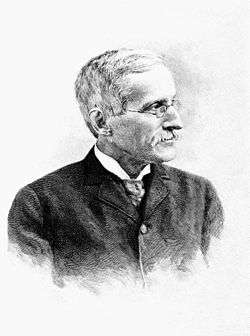Samuel William Johnson

Samuel William Johnson (3 July 1830 Kingsboro, New York – 1909) was a United States agricultural chemist. He promoted of the movement to bring the sciences to the aid of American farmers through agricultural experiment stations.
Biography
Samuel was the son of Abner Adolphus Johnson and Annah Wells Gilbert. Abner was Samuel’s first teacher; later he studied with David Mayhew in a school at Lowville, New York. Early on he obtained a textbook on chemistry by Fresenius where he learned methods of analysis.[1]
Gaining admission to Yale University, Samuel took lessons from John Pitkin Norton, Benjamin Silliman, Benjamin Silliman, Jr. and James Dwight Dana among others. Upon graduation he went to Leipzig, studying with Otto Linne Erdmann. The next year he went to Munich and Liebig's lab. He studied physiological chemistry with Max Joseph von Pettenkofer and Wolfgang Franz von Kobell. Returning through England, he visited the lab of Edward Frankland and the experimental farms of John Bennet Lawes and Joseph Henry Gilbert.
In 1858, he became a chemist for the Connecticut Agricultural Society, in which capacity he issued an important series of papers on commercial fertilizers and allied subjects. In 1866, he became a member of the Connecticut State Board of Agriculture. Also in 1866, he was elected to the National Academy of Sciences.
Johnson’s skill with analytical chemistry brought him the position of First Assistant at the Yale Analytical Lab in 1874. A year later he was made professor of analytical chemistry. The following year he was also named professor of Agricultural Chemistry. He regularly attended meetings of agricultural societies and farmers' clubs.
He was director of the Connecticut Agricultural Experiment Station from 1877 to 1899. In 1878 Johnson was president of the American Chemical Society.
Johnson retired in 1896.
Works
- Peat and its uses as a fertilizer and fuel (1859) from Google books
- Essays on peat, muck, and commercial manures(1866) from Google books
- How Crops grow (1868)
- How Crops Feed: A treatise on the atmosphere and soil as related to the nutrition of agricultural plants (1870)
- Chemical Notation and Nomenclature (1870)
He edited Fresenius' Quantitative Chemical Analysis (1864, 1875, 1883).
Notes
- ↑ Osborne 1911
References
-
 Rines, George Edwin, ed. (1920). "Johnson, Samuel William". Encyclopedia Americana.
Rines, George Edwin, ed. (1920). "Johnson, Samuel William". Encyclopedia Americana. -
 Gilman, D. C.; Thurston, H. T.; Colby, F. M., eds. (1905). "Johnson, Samuel William". New International Encyclopedia (1st ed.). New York: Dodd, Mead.
Gilman, D. C.; Thurston, H. T.; Colby, F. M., eds. (1905). "Johnson, Samuel William". New International Encyclopedia (1st ed.). New York: Dodd, Mead.
External links
- Thomas Burr Osborne (1911) Samuel William Johnson 1830 — 1909 from National Academy of Sciences.
- Works by Samuel William Johnson at Project Gutenberg
- Works by or about Samuel William Johnson at Internet Archive